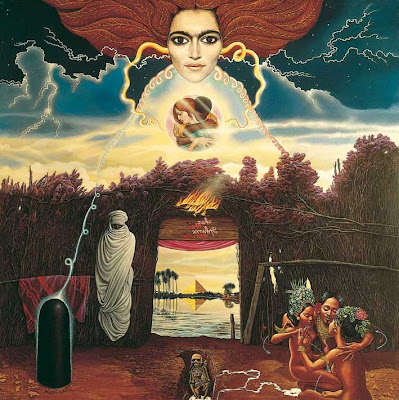I first came across this movie in an old post on Mounds and Circles. The Suns of Easter Island is a curiosity; a very of its time metaphysical adventure which feels like something between Chariots of the Gods, Close Encounters of the Third Kind, and abstract globe trotters like Koyaanisqatsi and Baraka. The plot concerns six unconnected individuals scattered across the globe who all experience a strange visionary episode, in which they witness hexagons, ancient architectures, stone heads, and scenes of contemporary unrest and strife. After the hallucinations subside, they discover that a silver disk has mysteriously and permanently imprinted itself on the palm of their right hands. Gradually, the six realize that some force is drawing them towards Easter Island on the date of a specific cosmic alignment, so that their minds can be used to make contact with an extraterrestrial species who establish a telepathic link with mankind every 500 years.
The early to mid-70s is a period I'm particularly fascinated by; it was a watershed era for Fortean/occult shenanigans. The idea of mental contact with extraterrestrial higher intelligence was very much in the ether during this strange time. On July 23, 1973, the great Robert Anton Wilson experienced the first of what he then suspected to be transmissions from an extraterrestrial intelligence located somewhere in the vicinity of the dog star Sirius. Timothy Leary, then doing the persecuted philosopher routine in Folsom prison, was also receiving downloads from a cosmic intelligence - a cosmic intelligence, it should be conceded, whose oracular pronouncements sounded more than a little like Leary himself. Philip K. Dick was writing the best fiction of his career, and was of course zapped by the motherlode of all cosmic transmissions in the legendary VALIS incident of '2-3-74'. The Suns of Easter Island taps into this weird zeitgeist beautifully - an era characterized by open-mindedness (often to the point of naivete), esoteric excitement, and a questing spirit sometimes cast adrift in the psychic fallout and hangover from the previous decade. As a French production, however, Suns can be located in a distinctly Gallic tradition of esoteric counterculture going back to Pauwels and Bergier's mighty The Morning of the Magicians.
While many may have interpreted the movie as borrowing heavily from von Daniken, it was in fact von Daniken who borrowed a great deal of his "Ancient Astronaut" thesis from Morning of the Magicians, and another French author called Robert Charroux. It's the sensibility of Pauwels and Bergier that the film apes the most, though - that unique melting pot of contemporary intellectual radicalism and occult revivalism, the authors' fascination with tracing the curve of the distant future in the scattered remnants of the deepest past - the absolute elsewhere from which my title is cribbed. The Suns of Easter Island was directed by tv/film screen-writer and director Pierre Kast, and beyond that, information about the film is quite scarce. It seems to have fallen completely off the radar. Though somewhat of an acquired taste, it's definitely worthy of cult re-discovery - it's a beautifully shot, atmospheric and expansive production that serves as a marvelous time capsule of the metaphysical preoccupations of the early 70s (click captions for English subs):
The screen grabs are from Mounds and Circles. Thanks to them for unearthing this forgotten gem, and thanks to von Drak for alerting me to the youtube upload.





















